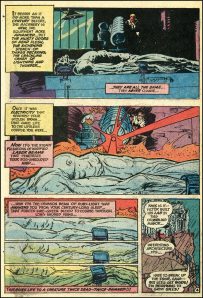Please post a question on the readings as a comment below. You can ask a question related to either the Digital Media Handbook or the Resnick book. Most of the class discussion will probably focus on Resnick. Also come prepared to discuss Frankenstein in its many incarnations (most recently with Aaron Eckhart as the monster).
Here are some pics of Frankenstein in comic book form by the amazing Mike Kaluta. Click the pic to get a larger version for reading and viewing.
And here’s a link to the entire comic: http://thegoldenagesite.blogspot.com/2012/09/michael-w_7.html



On page 137 of the Digital Media Handbook it says, “So even though the products that a company is developing and promoting may be physical objects or analogue media and not digital entities in themselves, such as newspapers or film, clothing or holidays, they are experienced within a social and commercial environment inherently bound up with digital experience.” Is this saying that all advertisements are portrayed though some form of social media?
I think what is implied is that since we all live in a world that is deeply interwoven with the digital through production, distribution, and consumption consequently nothing mediated, as such, can escape the effects of that digital imperative. Even old school print media – magazines, books and all – exist in the context of social media and digital production. And we as readers and makers must remain cognizant of that fact.
Resnick states, “If a person has only a hammer, the whole world looks like a nail. Indeed, a person’s perceptions and models of the world are strongly shaped by the objects that exist in the world” (44). This is true for computational systems because the way people interact with this system depends on the objects that compose the system. For example, if the objects are chosen for the intended task the system will be used productively however if they’re not well chosen the users will struggle.
In Resnick’s section about “Parallelism,” I could not help but think of our culture of instant gratification. We want performance, so the very fact that only one program can work at a time just sounds tedious. “The lack of parallelism in Logo violates the principle that simple things should be simple” (Resnick 45). Do you believe that our continual want of having multiple programs/apps/tabs all at once will ever die down? Does the use of programs like Logo, make life simpler just for the now?
On page 116 of the Digital Media Handbook, Matt Locke states” We used to ask what are the different networks we can release out culture into. Now, instead we ask how are we going to manage the different patterns of attention.” I think that Locke is saying that there is such a struggle to manage so many different types of media and controlling how the audience is engaged and interacts with the message. Do you guys feel overwhelmed with how much media we are exposed to on a daily basis?
In Dewdney and Ride’s “The Digital Media Handbook”, under “The Digital Experience is Multi-Channel”, the authors write: “One examle is that the film industry understands how to use the technology to make content, but what they don’t understand is what’s happening to audiences. They now have a problem with marketing and find that the old pattern of marketing don’t work because audiences congregate in different places, they display different behaviours and use different devices. Yet understanding what people are doing, how you reach them and how you engage with them there is something that filmmakers don’t get” (p. 133). My question is: do you think that the filmmakers’ problem with marketing influences the way we interpret the film that we are watching on the screen?
In our Resnick book, the second chapter focuses on the constructionism of decentralized systems, after firmly establishing what decentralized system are in our first chapter. The author brings up an interesting point when he compares constructionism to instructionism. He says, ” Where as instructionism focuses on new ways for teachers to instruct, constructionism focuses on the ways for learners to construct. Both are important. But significant improvements in education are much more likely to come from advances in constructionism, not instructionism”(24). From a student standpoint and perspective i find our author’s logic of extreme value at this juncture. I believe students and my self included are better able to learn when we construct things that have intrinsic value and meaning to us, as opposed to being told by an authority figure what to construct. However, my question is in regard to Resnick’s own contradiction he brings up. He says, “After all how can you design a self-organizing phenomenon?”(24). Although StarLogo, and other programs like it may have a decentralized application I’m not entirely sure this is the case. Can programs be decentralized or, are all programs centralized in nature because it takes a central designer to create that program?
on page 32 Resnick speaks about how cellular automata is best suited for computer aficionados, and not for the masses. However it seems that if we teach correctly tho it could become suited for everyone. We would need to make people have enough experience with it. It is just like he said in the beginning, “The major challenge for educators and educational developers, then, is to create tools and environments that engage learners in construction, invention, and experimentation.” (page 24)
Our readings from “The Digital Media Handbook” as well as “Termites, Turtles, and Traffic Jams” discuss the importance of audience or student interaction. Dewdney and Ride are talking about media and television broadcasts while Resnick is discussing a classroom environment, both readings touch on an important human phenomenon. Last week, we talked about people always feeling the need to be in control of their media whether it be their Facebook profile or their YouTube channels. How do our readings from this week build on that idea of need for participation and control and what does this mean for the development of new media, especially in classrooms?
In Chapter 2, Resnick brings up the idea that virtual worlds offer many advantages to portraying a decentralized system. He states, “it is easy to create new sensory capabilities to the creatures. And it is easy to set up and control precise experimental controls” (31). Are virtual worlds still considered examples of decentralized systems? However, he brings up drawbacks such as the lack of emotional connectivity when the system is mediated through a computer screen. In a day where these virtual worlds are escalating in popularity, is this still a drawback? Or are individuals found to be emotionally invested participating in the layered interactions.
I had a more real-world question about parallelism that comes from Resnick’s reading. He compares the idea to the example that a LEGO amusement park should be able to run multiple tasks at once. This seems to analogize “parallelism” with “decentralized multitasking”. Although Resnick provides a lot of examples about the paradigm shift between centralized and decentralized task completion, is it even possible for us as modern students to implement such a style of goal-achieving? For example, if a group of 4 people were assigned a project (like, “make a 4 page website”), then they might delegate the workload between themselves: 1 person per page. However, a leader might make the process run a lot more smoothly. But, the act of delegation seems to be in itself centralized.
My question: In terms of group projects, how might we be able to be most efficient? What is the balance between parallelism and hierarchical thinking?
In Resnick’s book, he exclaims, “The constructionist approach goes beyond hands-on in a variety of ways… Students do not simply manipulate physical objects, they construct personally meaningful products.” (Page 28) Its important to note that this form of teaching pedagogy is tailored towards the needs of the students. It assumes that the student has a an understanding that through creativity one is able to learn and come to new forms of knowing. Yet, it is still important to point out that by emphasizing the personal one is able to be inspired by the unknown and letting the brain work.
How is this new way of learning a better alternate than the structures we currently have?
In The Digital Media Handbook, on page 127 Locke states “I think the reason we talk much less about the future now is that it is here now. Do you think this is true because we are unsure of how the digital world will look in 10 years?
A quote from Ch. 7 on Cultural convergence: “Previous subordinate cultural practices (sub-cultures) of young people in music, fashion and dance, have been taken into ‘mainstream’, culture through the fashion and music industries. On top of this consumer driven phenomena of cultural convergence, the advent of Web 2.0 has created the tools for all cultural activity to be uploaded and shared, bypassing the pervious ‘cultural gatekeepers’ of broadcasting and publishing.” Cultural convergence is becoming easier and easier to sustain through social media. How does this negatively or positively affect one cultures perception of another culture? Does cultural convergence in social media unify cultures or separate them?
In The Digital Media Handbook on page 101, Dewdney and Ride define and claim convergence as a “consequence of the digital tools used for media production in which software combines the manipulation of the moving with the still, graphic with the photographic, the typographic with the filmic, the visual with the sonic.” In the next paragraph, they discuss hybridity as the “reevaluation of old media through the prism of digital media.” So throughout convergence we see an opinion form of recyclical images seen through different lenses. In chapter 8 on pages116-117, the authors quote Matt Locke as he explores the similar idea of cohesion. He argues that through his experience he sees a shift in change that no longer supports a binary opposition of old and new. It may be my cynical way of thinking but through this idea of convergence, are we exploring new territory by redefining the old? Matt Locke spoke about managing the different patterns of attention but with many more individual outlets of opinion, changing public opinion has become harder even for the PR pros. Have we lost the ability to predict the future of tech system usage, and if so, could it be a good thing?
In our Digital Media Handbook, the authors discuss how we are connected with media in some way and how media is such a large part of our lives (p.137). Our text explains how the influence of media controls and/or influences how us, the audience, perceives the message and how we respond to it. We see this all the time in our daily lives, especially with the popularity boom of social media sites such as Facebook and Instagram. Do we rely too much on media nowadays? Do we spend our lives living through media or do we let it control some aspects of our lives?
In “The Digital Media Handbook”, in sub section “The Digital Experience is Multi-Channel”, authors Dewdney and Ride, talk about how the film industry doesn’t understand how the audience decodes the film and the advertising of film. Film makers know how to use the technology to create their piece but don’t understand how to get different audiences to understand. With this being said, what would the film industry need to do to fix or improve on their marketing problem? Also, when thinking of the marketing problem of film…wouldn’t the progress of improving the marketing depend on the genre of film and what groups of people watch it? Different genres of film, in my opinion are not necessarily for everyone.
On page 137 of The Digital Media Handbook there is a lot of discussion at what the digital experience mean. Richard Sedley answers. “that they help companies make better decisions. The goal for the companies is to become more effective with their marketing…”. (137) My question would then be, is the digital experience only made possible through previous analogue technologies? I believe that digital expereince is enhanced through using previous forms of technology such as analogue technologies.